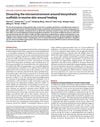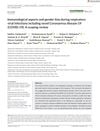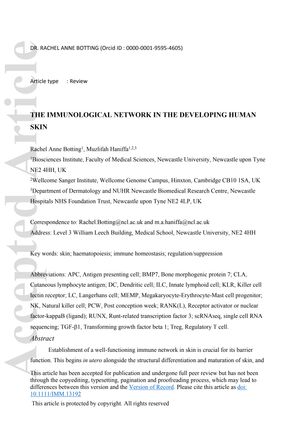TLDR Human prenatal skin develops an immune network early on that helps with skin formation and healing without scarring.
The document reviews the development of the immune network in human prenatal skin, detailing the presence and roles of various immune cells during gestation. It notes that immune cells, including Langerhans cells, dendritic cells, macrophages, T cells, and innate lymphoid cells, appear as early as 6 post-conception weeks (PCW) and contribute to the structural maturation and barrier function of the skin. The review finds that the prenatal skin environment supports immune cell differentiation and maintains an anti-inflammatory profile, which is essential for scarless wound healing and development. It also points out that while the immune cell composition in developing skin is less dense than in adult skin, it is diverse and plays a role in tissue generation and regeneration. The origins of these immune cells could be from the yolk sac, fetal liver, or bone marrow. The document suggests that further research into the functional maturity and specific developmental roles of these immune cells could enhance the understanding of inflammatory skin diseases and regenerative medicine.
 83 citations
,
June 2018 in “Frontiers in immunology”
83 citations
,
June 2018 in “Frontiers in immunology” Certain types of T cells are essential for healthy skin and play a role in skin diseases, but more research is needed to improve treatments.
 79 citations
,
January 2018 in “Wiley Interdisciplinary Reviews-Developmental Biology”
79 citations
,
January 2018 in “Wiley Interdisciplinary Reviews-Developmental Biology” Understanding how baby skin heals without scars could help develop treatments for adults to heal wounds without leaving scars.
86 citations
,
April 2016 in “Nature Communications” 175 citations
,
December 2014 in “PLoS Biology” Macrophages help activate hair follicle stem cells, affecting hair growth and skin repair.
405 citations
,
January 2004 in “Journal of Investigative Dermatology” Hair follicle size and distribution vary significantly across different body sites.
 66 citations
,
May 2021 in “Science Advances”
66 citations
,
May 2021 in “Science Advances” Different scaffold patterns improve wound healing and immune response in mouse skin, with aligned patterns being particularly effective.
 11 citations
,
May 2021 in “Journal of Medical Virology”
11 citations
,
May 2021 in “Journal of Medical Virology” Men are more likely to have severe respiratory viral infections like COVID-19 due to hormonal and genetic differences, while women generally have stronger immune responses.
 18 citations
,
November 2020 in “Frontiers in Cell and Developmental Biology”
18 citations
,
November 2020 in “Frontiers in Cell and Developmental Biology” Inflammation plays a key role in activating skin stem cells for hair growth and wound healing, but more research is needed to understand how it directs cell behavior.
 October 2023 in “bioRxiv (Cold Spring Harbor Laboratory)”
October 2023 in “bioRxiv (Cold Spring Harbor Laboratory)” Immune cells are essential for early hair and skin development and healing.
9 citations
,
August 2021 in “Experimental dermatology” Hidradenitis suppurativa is a skin disease caused by the breakdown of the skin's natural immune barriers, especially around hair follicles.
97 citations
,
May 2019 in “Frontiers in Cell and Developmental Biology” Abnormal ECM and immune cell interactions can cause skin diseases.






